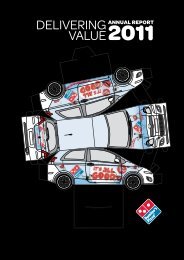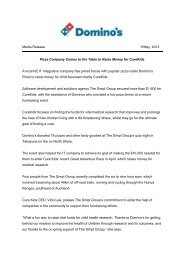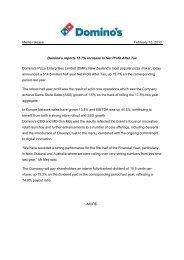2012 Annual Report - Domino's Pizza
2012 Annual Report - Domino's Pizza
2012 Annual Report - Domino's Pizza
You also want an ePaper? Increase the reach of your titles
YUMPU automatically turns print PDFs into web optimized ePapers that Google loves.
3.20 Impairment of tangible and intangible<br />
assets excluding goodwill<br />
At the end of each reporting period, the<br />
Consolidated entity reviews the carrying<br />
amounts of its tangible and intangible assets to<br />
determine whether there is any indication that<br />
those assets have suffered an impairment loss.<br />
If any such indication exists, the recoverable<br />
amount of the asset is estimated in order to<br />
determine the extent of the impairment loss (if<br />
any). Where it is not possible to estimate the<br />
recoverable amount of an individual asset, the<br />
Consolidated entity estimates the recoverable<br />
amount of the cash-generating unit to which<br />
the asset belongs. Where a reasonable and<br />
consistent basis of allocation can be identified,<br />
corporate assets are also allocated to individual<br />
cash-generating units, or otherwise they<br />
are allocated to the smallest group of cashgenerating<br />
units for which a reasonable and<br />
consistent allocation basis can be identified.<br />
Intangible assets with indefinite useful<br />
lives and intangible assets not yet available<br />
for use are tested for impairment annually<br />
and whenever there is an indication<br />
that the asset may be impaired.<br />
Recoverable amount is the higher of fair<br />
value less costs to sell and value in use. In<br />
assessing the value in use, the estimated<br />
future cash flows are discounted to their<br />
present value using a pre-tax discount rate<br />
that reflects current market assessments<br />
of the time value of money and the risks<br />
specific to the asset for which the estimates<br />
of future cash flows have not been adjusted.<br />
If the recoverable amount of an asset (or<br />
cash-generating unit) is estimated to be<br />
less than its carrying amount, the carrying<br />
amount of the asset (cash-generating unit)<br />
is reduced to its recoverable amount. An<br />
impairment loss is recognised immediately<br />
in profit or loss, unless the relevant asset<br />
is carried at the revalued amount, in which<br />
case the impairment loss is treated as a<br />
revaluation decrease (see 3.15 above).<br />
Where an impairment loss subsequently<br />
reverses, the carrying amount of the asset<br />
(cash-generating unit) is increased to the<br />
revised estimate of its recoverable amount, but<br />
so that the increased carrying amount does<br />
not exceed the carrying amount that would<br />
have been determined had no impairment<br />
loss been recognised for the asset (cashgenerating<br />
unit) in prior years. A reversal of<br />
an impairment loss is recognised immediately<br />
in profit or loss, unless the relevant asset<br />
is carried at fair value, in which case the<br />
reversal of the impairment loss is treated as<br />
a revaluation increase (see 3.15 above).<br />
3.21 Employee benefits<br />
A liability is recognised for benefits accruing<br />
to employees in respect of wages and<br />
salaries, annual leave, long service leave,<br />
and sick leave when it is probable that<br />
settlement will be required and they are<br />
capable of being measured reliably.<br />
Liabilities recognised in respect of short-term<br />
employee benefits, are measured at their<br />
nominal values using the remuneration rate<br />
expected to apply at the time of settlement.<br />
Liabilities recognised in respect of long term<br />
employee benefits are measured as the<br />
present value of the estimated future cash<br />
outflows to be made by the Consolidated<br />
entity in respect of services provided<br />
by employees up to reporting date.<br />
Contributions to defined contribution<br />
superannuation plans are expensed<br />
when employees have rendered service<br />
entitling them to the contributions.<br />
3.22 Provisions<br />
Provisions are recognised when the<br />
Consolidated entity has a present obligation<br />
(legal or constructive) as a result of a past<br />
event, it is probable that the Consolidated<br />
entity will be required to settle the<br />
obligation, and a reliable estimate can be<br />
made of the amount of the obligation.<br />
The amount recognised as a provision is the<br />
best estimate of the consideration required to<br />
settle the present obligation at reporting date,<br />
taking into account the risks and uncertainties<br />
surrounding the obligation. Where a provision<br />
is measured using the cash flows estimated<br />
to settle the present obligation, its carrying<br />
amount is the present value of those cash flows.<br />
When some or all of the economic benefits<br />
required to settle a provision are expected<br />
to be recovered from a third party, the<br />
receivable is recognised as an asset if it<br />
is virtually certain that reimbursement<br />
will be received and the amount of the<br />
receivable can be measured reliably.<br />
3.22.1 Onerous contracts<br />
Present obligations arising under onerous<br />
contracts are recognised and measured<br />
as a provision. An onerous contract is<br />
considered to exist where the Consolidated<br />
entity has a contract under which the<br />
unavoidable costs of meeting the obligations<br />
under the contract exceed the economic<br />
benefits expected to be received under it.<br />
3.22.2 Make good obligations<br />
A provision is recognised for the make<br />
good obligations in respect of restoring<br />
sites to their original condition when the<br />
premises are vacated. Management has<br />
estimated the provision based on historical<br />
data in relation to store closure numbers<br />
and costs, as well as future trends that<br />
could differ from historical amounts.<br />
3.22.3 Contingent liabilities acquired<br />
in a business combination<br />
Contingent liabilities acquired in a business<br />
combination are initially measured at fair<br />
value at the date of acquisition. At subsequent<br />
reporting periods, such contingent liabilities are<br />
measured at the higher of the amount that would<br />
be recognised in accordance with AASB 137<br />
‘Provisions, Contingent Liabilities and Contingent<br />
Assets’ and the amount initially recognised<br />
less cumulative amortisation recognised in<br />
accordance with AASB 118 ‘Revenue’.<br />
3.23 Financial liability and Equity Instruments<br />
3.23.1 Classification as debt and equity<br />
Debt and equity instruments are classified as<br />
either liabilities or as equity in accordance with<br />
the substance of the contractual arrangement.<br />
3.23.2 Equity instruments<br />
An equity instrument is any contract<br />
that evidences a residual interest in the<br />
assets of an entity after deducting all of<br />
its liabilities. Equity instruments issued by<br />
the Consolidated entity are recorded at the<br />
proceeds received, net of direct issue costs.<br />
3.23.3 Financial guarantee contract liabilities<br />
Financial guarantee contract liabilities<br />
are measured initially at their fair values<br />
and, if not designated as at FVTPL,<br />
are subsequently at the higher of:<br />
• the amount of the obligation under the<br />
contract, as determined in accordance<br />
with AASB 137 ‘Provisions, Contingent<br />
Liabilities and Contingent Assets’; and<br />
• the amount initially recognised less, where<br />
appropriate, cumulative amortisation in<br />
accordance with the revenue recognition<br />
policies set out in 3.8 above.<br />
3.23.4 Financial liabilities<br />
Financial liabilities are classified as<br />
either financial liabilities ‘at FVTPL’<br />
or ‘other financial liabilities’.<br />
ANNUAL REPORT <strong>2012</strong> DOMINO’S PIZZA ENTERPRISES LIMITED 41













